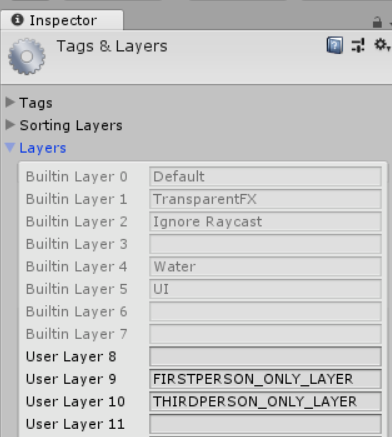How to Use VRMFirstPerson
Tue, May 29, 2018VRMFirstPerson Settings
VRMFirstPerson has the following settings for Renderer:
| FirstPersonFlag | Layer | Note |
|---|---|---|
| Both | default | Specify parts that are not necessarily separated between first-person view and third-person view. |
| ThirdPersonOnly | THIRDPERSON_ONLY_LAYER | Specify parts that are not rendered in first-person view. |
| FirstPersonOnly | FIRSTPERSON_ONLY_LAYER | Specify parts that are not rendered in third-person view. The auto-created headless model is used. |
| Auto | THIRDPERSON_ONLY_LAYER | Automatically create the model in first-person view at runtime and set it to FIRSTPERSON_ONLY_LAYER. |
By calling VRMFirstPerson.Setup at runtime, the layer settings described above can be performed. Please call the function explicitly from outside.
Specify the additional render layers for the application
The following layers are defined as constant:
public class VRMFirstPerson : MonoBehaviour
{
public const int FIRSTPERSON_ONLY_LAYER = 9;
public const int THIRDPERSON_ONLY_LAYER = 10;
// The following parts are omitted
}
|
|---|
| Set Layer in #9 and #10 |
Call Setup function at runtime and set LayerMask in Camera
- Call VRMFirstPerson.Setup
- Set LayerMask for first-person camera view and other camera views
using System.Collections;
using System.Collections.Generic;
using UnityEngine;
using VRM;
public class SetupExample : MonoBehaviour
{
[SerializeField]
Camera m_firstPersonCamera; // HMD camera
[SerializeField]
LayerMask m_firstPersonMask; // Set a first-person mask (default | FIRSTPERSON_ONLY_LAYER, etc.) in HMD camera
[SerializeField]
LayerMask m_otherMask; // Set other masks (default | THIRDPERSON_ONLY_LAYER, etc.) in HMD camera
[SerializeField]
VRMFirstPerson m_firstPerson;
void Reset()
{
m_firstPerson = GameObject.FindObjectOfType<VRMFirstPerson>();
}
void Start()
{
foreach (var camera in GameObject.FindObjectsOfType<Camera>())
{
camera.cullingMask = (camera == m_firstPersonCamera)
? m_firstPersonMask
: m_otherMask
;
}
// VRMFirstPerson initialization
if (m_firstPerson != null)
{
m_firstPerson.Setup();
}
}
}